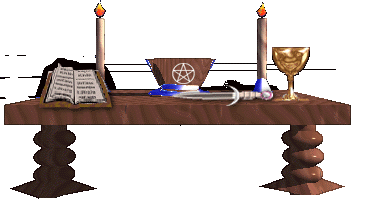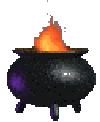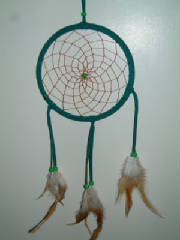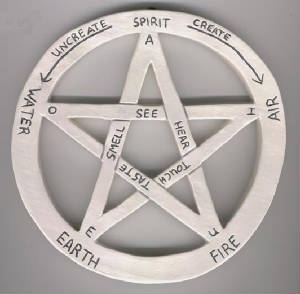|

Altar
The altar or working space is the first thing you'll need in any magickal working. Ideally, you should have a special
room for this, but few of us live in ideal situations.
You altar can be as simple as a coffee table or as elaborate as you wish.
The ritual altar serves a dual purpose; its a place to keep your ritual tools and materials, and it serves as a visual
focus for your magickal work. Some traditions hold that the altar should always face a certain direction, but you should put
it where it feels right to you.
More important, put it somewhere you will be able to see it easily, where you'll be able to reach the things you need
to reach, and where you won't trip over it.
The right side of the altar is usually dedicated to the God. A red, yellow or gold candle, or an appropriate figure is
usually placed there, as are the censer, wand, athame, boline and a bowl of salt.
The left half of the altar is usually dedicated to the Goddess. Tools sacred to Her are placed there; the cup, the pentacle,
the bell, crystals, cauldron and a bowl of water. An image of the goddess may also stand there, or a green, silver or white
candle can be substituted.
The besom or broom may be laid against the left side of the altar. The cauldron is also sometimes placed on the floor
to the left of the altar if there isn't room on top.
Athame
Your athame (or personal knife) should be purchased new, the shape and size depending upon what appeals to you. In the
Wiccan tradition the hilt is usually black and the blade sharp on both sides. The blade should also be of a metal that can
be sharpened as you will use this knife to cut herbs and incise candles. The sharp edge is also a reminder of the power we
take into our hands when we work magick.
If you do purchase a used athame be very certain there are no negative vibrations on it. Cleanse and consecrate it before
use.
Bell
Some Wiccans use a bell in their rituals, though certainly not all. Sound is vibration, and vibrations are important,
not only in everyday life but especially in magick. To help acheive the right vibrations, the right "mood" or "frequency"
it helps to ring a bell. It can actually be just as effective as the burning of incense, which also affects vibrations. Don't
overdo the bell ringing. A very occasional single, double or triple ring scattered throughout the ritual can be far more effective
than a constant jangling.
The bell you use should be chosen carefully. Don't just take any bell - each has its own particular timbre. Find one
which seems "right" to you, one which soothes and mellows rather than one which is harsh and strident. If possible, remove
the handle and replace it with a leather loop. In this way you can carry the bell strung from your belt (if you prefer that
is).
The bell is a feminine symbol and so is often used to invoke the Goddess in ritual. It is also rund to ward off evil
spells and spirits, to halt storms, or to evoke good energies. Placed in cupboards or hung on the door it guards the home.
Besom/Broom
The besom is used to cleanse the ritual area. There are those who insist that e basom must be made of a broom, but this
isn't necessarily true. In fact, it is said that fairies hate the scenet of the broom. Straw or grass brooms are fine for
indoors, while outdoors, any leafy twig found on the ground will work well. Many stores and craft shops carry the old-fashioned
"witch" broom made of straw or grass which is perfectly acceptable as long as it feels right to you.
To cleanse your circle, start in the centre and moving deosil sweep the circle from the centre to the outer edges, all
the while envisioning and chanting that negativity is being swept out and the circle is being cleaned.
Book of Shadows
One of the most important items is the Book of Shadows, or Journal if you prefer. This is where you should record everything
associated with your journey: rituals, spells, thoughts, inspirations and any other information you deem needful. It can be
in any form you choose.
Boline
This is usually a white handled knife traditionally used for physical cutting if you don't want to use your Athame for
that. It is simply a practical, working tool as opposed to a purely ritualistic magick knife. It is used to cut wands or sacred
herbs, inscribe symbols onto candles, wood, clay or wax, and in cutting cords for use in magick.
Some Wiccans dictate that the white handled knife be used only within the magick circle. This would, of course, limit
its usefulness. Do what feels right to you.
Candles
Candles are associated with Fire and Air, and are used for everything from lighting the altar to specifics in spells.
The type of wax does not matter. Colour is what is important here. For basic magickal working the basic candle colours needed
are white, black, green, red, yellow and blue.

Cauldron
The cauldron is an essential in Celtic magick. It represents the element of Water. the cauldron is mentioned in many
Celtic myths and is always connected with magickal happenings. Black cast iron is best and most traditional, although it can
be made of other metals.
Filled with water it can be used as a scrying toom, similar to a magick mirror or crystal ball. During certain spells
candles are set in it and allowed to burn out. It is an all purpose tool, a vital part of your Celtic spellworkings.
The Wicca see the cauldron as a symbol of the Goddess, the manifested essence of femininity and fertility. Ideally the
cauldron should stand on three legs, its opening smaller than its widest part.
Chalice
Your chalice or goblet can be of any shape, size or composition. Beware of pretty pewter cups, they contain lead and
can be dangerous to drink anything from, especially wine. The chalice holds water or wine, but is occasionally used empty.
The chalice, like the cauldron, is of the Element of Water and associated with the West. It may be used for everyday drinking
but is usually reserved for occasions when it is felt necessary to pour libations to the Gods, or similar ritual use.

Dream Catcher
As a Native American legend is told, by hanging a dream catcher over your sleeping area the bad dreams will be dterred
by the central bead. The feathers will attract and allow good dreams to pass through.
Herbs and Oils
Herbs are often burned for incense during a spell or ritual. Charcoal blocks are available for this purpose in gift and
candle shops as well as new age and occult supply stores.
Essential oils are used for anointing candles, tools, the altar and the body in rituals and spellworking. They may be
used as tokens of esteem and respect for the deities and energies of the Craft. As plants of various kinds have customarily
been offered to the Lady, herbal offerings can be especially meaningful for their particular significance and properties.
Since all herbs and oils have their own particular energies thay can be a valuable, if not essential, addition to your magickal
materials. Herbs are always associated with the Element of Earth.
Incence Censer or Burner
A good incense burner is essential, especially if you plan to use the better incenses that are burned on charcoal. Choose
a burner that has some sort of a foot or stand under it. Fill it with a layer of fresh sand which makes it easier to clean
and cuts down on the heat that will pass into the altar. If you can't find a suitable censer, make one. Any bowl or cup will
serve well provided that you fill it at least halfway with salt or sand. If you plan to move it at all while hot, chains or
handles are a necessity.
Representative of the Element of Fire and aligned with the South, the incense burner can also be used in spells that
require the burning of paper.
Pendulum
The pendulum is a divinatory tool used to answer simple yes or no questions. To use, hold the pendulum 10cm up the chain
between thumb and forefinger, ensuring the chain is hanging straight down. Ask the pendulum to show you a yes. Whatever direction
it swings, clockwise or anticlockwise is you 'yes' and the opposite 'no'. Concentrate and ask your questions.

Pentacle
A pentacle is traditionally a flat disk made of metal or wood and is inscribed with a pentagram. It is used as a power
point for consecrating ritual objects, such as water or wine in a chalice, amulets and tools, and is associated with the Earth
Element and aligned with the North. It can also be used for grounding stray energy in a room.
The pentacle was "borrowed" from ceremonial magick. In this ancient art it was often an instrument of protection, or
a tool used to evoke spirits. Pentacles are also hung over doors and windows to act as protective devices, or are ritually
manipulated to draw money owing to the pentacle's Earth associations.
Robes
A robe that is only saved for spellworking can be a fundamental part of your magickal paraphernaila. It can be plain,
decorated, and of any colour that appeals to you, as long as it makes you feel "magickal." It is nice to have more than one
robe, each in a different colour. The colours can be matched to the candle colours required for a particular spellworking.
If you don't like the idea of a robe, wear whatever feels comfortable to you. The idea is to feel at ease, not to be
"fashionable."
Stones and Crystals
Colourful stones of various shapes and sizes are used in some spellworks. Whether you purchase them or find them yourself,
be certain that their vibrations feel comfortable to you. Crystals and other stones are good conductors of magickal energy
in their natural state and need not be polished to be of use.
Alll stones and crystals are of teh Element Earth and play an important part in Cenltic spellworkings.
Sword
The sword, like the staff, is a tool of command. It is not used often, but can be necessary for certain spellworkings.
Its size, style and length are a personal choice, just be carful that you can easily handle the sword you choose. Like the
Athame, the sword is of the Element of Fire.
Wand/Staff
Traditionally, both a wand and a staff should be of wood and made by the person who will use them. If you purchase these,
or have them made, fill them with your own vibrations before using them. This is easily done by handling them often and deliberately
sending your own positive thoughts into the object. The wand and staff can be naturally formed tree branches or made of dowels
ornamented with crystals, stones, wooden beads or whatever else you fancy.
The length of the wand depends upon what feels comfortable to you, but tradition states that it should be no longer than
your forearm.
The staff should be at least shoulder high and as thick as is comfortable to hold. It should be cut during the waxing
moon and be allowed to dry out thoroughly at room temperature. The staff is the sword and the wand rolled into one, and as
such is a symbol of both magickal knowledge and the right to petition deities or archetypal powers.
Both Staff and Wand are of the Element or Air and are aligned with the East.
Back to Associations and Correspondances

|

